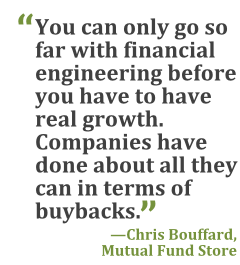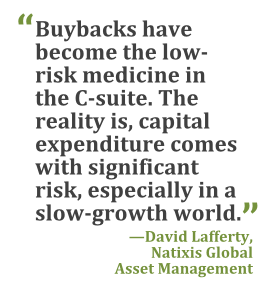Companies in the Standard & Poor's 500 Index really lovetheir shareholders. Maybe too much.
|They're poised to spend US$914 billion on share buybacks anddividends this year, or about 95 percent of earnings, data compiledby Bloomberg and S&P Dow Jones Indices show. Money returned tostock owners exceeded profits in the first quarter and may again inthe third. The proportion of cash flow used for repurchases hasalmost doubled over the last decade while it's slipped for capitalinvestments, according to Jonathan Glionna, head of U.S. equitystrategy research at Barclays Plc.
|Buybacks have helped fuel one of the strongest rallies of thepast 50 years as stocks with the most repurchases gained more than300 percent since March 2009. Now, with returns slowing, investorssay executives risk snuffing out the bull market unless they startplowing money into their businesses.
| “You can only go so far with financial engineering beforeyou actually have to have a business with real growth,” ChrisBouffard, chief investment officer who oversees $9 billion atMutual Fund Store in Overland Park, Kansas, said by phone on Oct.2. “Companies have done about all that they can in terms ofmaximizing the ability to do those buybacks.”
“You can only go so far with financial engineering beforeyou actually have to have a business with real growth,” ChrisBouffard, chief investment officer who oversees $9 billion atMutual Fund Store in Overland Park, Kansas, said by phone on Oct.2. “Companies have done about all that they can in terms ofmaximizing the ability to do those buybacks.”
S&P 500 constituents will probably say earnings rose 4.9percent in the third quarter when they begin reporting results thisweek, according to more than 10,000 analyst estimates compiled byBloomberg. Alcoa Inc., Yum! Brands Inc., and Monsanto Co. are amongnine companies scheduled to announce financial details.
|U.S. equities rebounded from last week's retreat, with theS&P 500 rising 0.4 percent at 9:55 a.m. in New York. TheS&P 500 Buyback Index is up 7.5 percent this year through Oct.3, compared with the 6.5 percent advance in the S&P 500, afterbeating it by an average of 9.5 percentage points every year since2009.
|While the ratio to earnings shows how buybacks and dividendscompare to past economic expansions, it doesn't indicate thatcompanies are struggling to fund them. Five years of profit growthhave left S&P 500 constituents with US$3.59 trillion in cashand marketable securities, and they've raised almost US$1.28trillion in 2014 through bond sales, headed for a record.
|“Buybacks are something corporations can take control of, and atlow borrowing costs, they're a viable option,” Randy Bateman, chiefinvestment officer of Huntington Asset Advisors, which managesabout US$2.8 billion, said by phone on Oct. 1. At the same time, hesaid, “If management can't unearth future opportunities for growth,as a shareholder, I lose confidence.”
|Earnings Barrier
|S&P 500 companies will spend $565 billion on repurchasesthis year and raise dividends by 12 percent to $349 billion, basedon estimates by Howard Silverblatt, an index analyst at S&P.Profits would reach $964 billion should the 8 percent growthforecast by analysts tracked by Bloomberg come true.
|Profits climbed to about $230 billion over the last threemonths, based on analyst forecasts. That compares with totalbuybacks and dividends of about $235 billion, assuming repurchasesestimated by Silverblatt are evenly divided between the third andfourth quarters. Cash returned to shareholders exceeded profits inthe first quarter for the first time since 2009, data compiled byBloomberg and S&P show.
|“We're at a point [where] you sort of question whether they cancontinue to rise from here,” Glionna said in a phone interview onOct. 1 from New York. “This kind of 100 percent earnings is abarrier. It can bounce around here and there, but it doesn't gomuch above that.”
||Excluding the recession years of 2001 and 2008, dividends andstock buybacks have represented, on average, 85 percent ofcorporate earnings since 1998. The last time payouts exceededincome, in 2007, the buyback index fell 4.7 percent, compared witha 3.5 percent gain in the S&P 500. Equities peaked that Octoberbefore losing more than half their value.
| CEOs have increased the proportion of cash flow allocatedto stock buybacks to more than 30 percent, almost double where itwas in 2002, data from Barclays show. During the same period, theportion used for capital spending has fallen to about 40 percentfrom more than 50 percent.
CEOs have increased the proportion of cash flow allocatedto stock buybacks to more than 30 percent, almost double where itwas in 2002, data from Barclays show. During the same period, theportion used for capital spending has fallen to about 40 percentfrom more than 50 percent.
The reluctance to raise capital investment has left companieswith the oldest plants and equipment in almost 60 years. Theaverage age of fixed assets reached 22 years in 2013, the highestlevel since 1956, according to annual data compiled by the CommerceDepartment.
|'C Suite'
|Stock repurchases worth almost $2 trillion have helped buoy thebull market since March 2009. The S&P 500 has gone without a 10percent decline for three years and is up 191 percent amid a5-1/2-year bull run. Even as sales were stuck at an average growthrate of 2.6 percent a quarter in the past two years, per-shareearnings expanded more than twice as fast, 6.1 percent, datacompiled by Bloomberg show.
|During the first half of 2014, more than one-fifth of S&P500 companies cut their share count by at least 4 percent in thefirst half, Silverblatt estimated.
|“Buybacks have become sort of the low-risk medicine in theC-suite,” David Lafferty, the chief market strategist for NatixisGlobal Asset Management in Boston, said by phone on Oct. 2. Hisfirm manages about $930 billion. “The reality is, capitalexpenditure comes with risk, significant amount of risk, especiallyin a slow-growth world. Buybacks offer a lot of flexibility.”
|FedEx Corp. added 15 cents, or 7 percent, to its EPS in thelatest quarter through buybacks. The Memphis, Tennessee-basedshipping company authorized a repurchase program of as many as 15million shares last month while keeping its capital spending forthe fiscal year at $4.2 billion.
|Juniper Networks Inc., bowing to pressure by activist hedgefunds Elliott Management Corp. and Jana Partners LLC, announcedplans in February to return at least $3 billion to shareholders. InAugust, the Sunnyvale, California-based maker of networkingequipment said it will complete $2 billion of buybacks by the endof this year, achieving the target earlier than expected.
|The company had “an unusually high” cash flow of $425 millionduring the second quarter, Chief Financial Officer Robyn Denholmsaid in a conference call on Aug. 12. “We obviously haveaccelerated our buyback not just because of the cash results, butalso because of the opportunistic nature of the capital returnsthat we're doing at the moment.”
|Juniper Networks offered buybacks equivalent to 10.9 percent ofits stock price over the 12 months through June, more than doubleits earnings yield of 3.96 percent, data compiled by Bloomberg andS&P show.
|“It's going to be harder and harder to justify using thatcapital to buy back stocks at record highs,” Tim Courtney, whohelps oversee about $1.3 billion as chief investment officer ofExencial Wealth Advisors, said in a phone interview from OklahomaCity on Oct. 1. “Money has to be diverted to other places to keepoperations going. The point of concern is where the future growthis going to come from.”
Complete your profile to continue reading and get FREE access to Treasury & Risk, part of your ALM digital membership.
Your access to unlimited Treasury & Risk content isn’t changing.
Once you are an ALM digital member, you’ll receive:
- Critical Treasury & Risk information including in-depth analysis of treasury and finance best practices, case studies with corporate innovators, informative newsletters, educational webcasts and videos, and resources from industry leaders.
- Exclusive discounts on ALM and Treasury & Risk events.
- Access to other award-winning ALM websites including PropertyCasualty360.com and Law.com.
*May exclude premium content
Already have an account? Sign In
© 2024 ALM Global, LLC, All Rights Reserved. Request academic re-use from www.copyright.com. All other uses, submit a request to [email protected]. For more information visit Asset & Logo Licensing.







